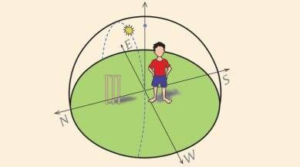Published on: April 27, 2023
Zero Shadow Day
Zero Shadow Day
Why in news? Bengaluru experienced a ‘Zero Shadow Day’, when vertical objects appear to cast no shadow. This was because the sun was at its zenith, and so the shadow was directly under the object.
Highlights:
- The Sun reaches exactly overhead at (12:17 pm) in Bengaluru and at all places along the 130 north Latitude.
What is Zero Shadow Day?
- The shadow of any vertical object would disappear at that instant.
- Zero Shadow Day occurs on different days in places away from 130 latitude.
- For every point on Earth between the Tropic of Cancer and the Tropic of Capricorn, there are two Zero Shadow Days a year. One falls during the Uttarayan when the Sun moves northwards, and the other is during Dakshinayan when the Sun moves southwards
- The Zero Shadow Day is restricted to locations between the tropics and so places north of Ranchi in India are out of it.
Why does a Zero Shadow Day happen?
- Uttarayan (movement of the Sun from south to north from winter solstice to summer solstice) and Dakshinayan (back from north to south) happen because Earth’s rotation axis is tilted at an angle of roughly 23.5° to the axis of revolution around the Sun.
- the Sun’s location moves from 23.5°N to 23.5°S of Earth’s equator and back. All places whose latitude equals the angle between the Sun’s location and the equator on that day experience zero shadow day, with the shadow beneath an object at local noon.

